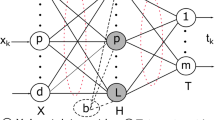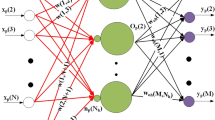Abstract
This paper describes a computational learning model inspired by the technology of optical thin-film multilayers from the field of optics. With the thicknesses of thin-film layers serving as adjustable “weights” for the computation, the optical thin-film multilayer (OTFM) model is capable of approximating virtually any kind of nonlinear mapping. This paper describes the architecture of the model and how it can be used as a computational learning model. Some sample simulation calculations that are typical of connectionist models, including a pattern recognition of alphabetic characters, iris plant classification, and time series modelling of a gas furnace process, are given to demonstrate the model’s learning capability.
Similar content being viewed by others
References
E. Anderson, The irises of the gaspe peninsula, Bull. Amer. Iris Soc. 59 (1935) 2-5.
M. Born and E. Wolf, Principles of Optic (Pergamon Press, New York, 1980).
G.E.P. Box and G.M. Jenkins, Time Series Analysis, Forecasting and Control (Holden Day, San Francisco, 1970).
W.E. Case, New synthesis method for optical thin-film coatings, Appl. Optics 22(4) (1983) 4111-4117.
J.A. Dobrowolski and R.A. Kemp, Refinement of optical multilayer systems with different optimization procedures, Appl. Optics 29(19) (1990) 2876-2893.
J.D. Farmer, A Rosetta stone for connectionism, Phys. D 42 (1990) 153-187.
D.E. Goldberg, Genetic Algorithms in Search, Optimization and Machine Learning (Addison-Wesley, University of Alabama, 1989).
A. Hart, Using neural networks for classification tasks — some experiments on datasets and practical advice, J. Oper. Res. Soc. 43 (1992) 215-226.
J. Hertz, A. Krogh and R.G. Palmer, Introduction to the Theory of Neural Computation (Addison-Wesley, Redwood City, CA, 1991).
G.E. Hinton, Connectionist learning procedures, Artif. Intell. 40 (1989) 185-189.
L. Levi, Applied Optics, Vol. II (Wiley, New York, 1980).
X. Li, Connectionist learning architecture based on an optical thin-film multilayer model, Ph.D. thesis, University of Otago, Dunedin, New Zealand (1997).
H.M. Liddell, Computer-Aided Techniques for the Design of Multilayer Filter (Adam Hilger, Bristol, 1981).
W. Pedrycz, P.C.F. Lam and A.F. Rocha, Distributed fuzzy system modelling, IEEE Trans. Systems, Man, Cybern. 25(5) (1995) 769-780.
M.K. Purvis and X. Li, Connectionist learning using an optical thin-film model, in: Proceedings of the 15th World Congress on Scientific Computation, Modelling and Applied Mathematics, Artificial Intelligence and Computer Science, Vol. 4, ed. A. Sydow (Wissenschaft und Technik Verlag, Berlin, 1997) pp. 239-244.
B.D. Ripley, Statistical aspects of neural networks, in: Networks and Chaos — Statistical and Probabilistic Aspects (Chapman and Hall, London, 1993) pp. 40-123.
R. Serra and G. Zanarini, Complex Systems and Cognitive Processes (Springer, Berlin, 1990).
S.M. Weiss and I. Kapouleas, An empirical comparison of pattern recognition, neural nets, and machine learning classification methods, in: Proc. 11th International Joint Conference on Artificial Intelligence, Detroit (1989) pp. 781-787.
Author information
Authors and Affiliations
Rights and permissions
About this article
Cite this article
Li, X., Purvis, M. Pattern recognition by an optical thin-film multilayer model. Annals of Mathematics and Artificial Intelligence 26, 193–213 (1999). https://doi.org/10.1023/A:1018911012905
Issue Date:
DOI: https://doi.org/10.1023/A:1018911012905




